

Compact Muon Solenoid
LHC, CERN
| CMS-PAS-HIG-19-010 | ||
| Measurement of Higgs boson production in the decay channel with a pair of $\tau$ leptons | ||
| CMS Collaboration | ||
| July 2020 | ||
| Abstract: Measurements of Higgs boson production in the channel where the Higgs boson decays to $\tau$ leptons are performed. The analysis uses events recorded in proton-proton collisions by the CMS experiment at the CERN LHC in 2016, 2017, and 2018 at a center-of-mass energy of 13 TeV. The data sets correspond to a total integrated luminosity of 137 fb$^{-1}$. The product of the $\mathrm{H}\rightarrow\tau \tau$ signal production cross section and branching fraction is measured to be 0.85$^{+0.12}_{-0.11}$ times the standard model expectation. This analysis targets primarily the gluon fusion and the vector boson fusion production modes. Measurements of the signal strengths and products of the cross section and branching fraction are also performed in the simplified template cross section scheme, providing precise measurements of the Higgs boson production at high transverse momentum and in event topologies with jets. | ||
|
Links:
CDS record (PDF) ;
CADI line (restricted) ;
These preliminary results are superseded in this paper, Submitted to EPJC. |
||
| Figures | |
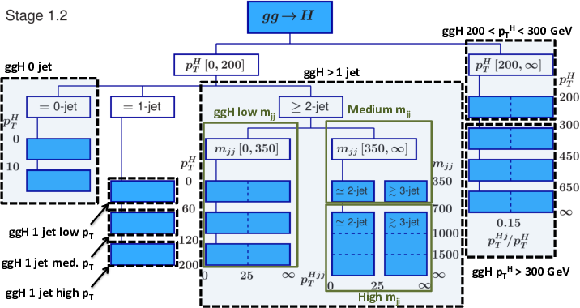
png pdf |
Figure 1:
Binning of the ggHproduction in the STXS stage 1.2 scheme. The dashed black boxes indicate the process-based merging detailed in Section 9. The green boxes indicate the differences in merging for the topology-based merging explained in the same section. |

png pdf |
Figure 2:
Binning of the qqH production in the STXS stage 1.2 scheme. The dashed black boxes indicate the process-based merging detailed in Section 9. The green boxes indicate the differences in merging for the topology-based merging explained in the same section. |
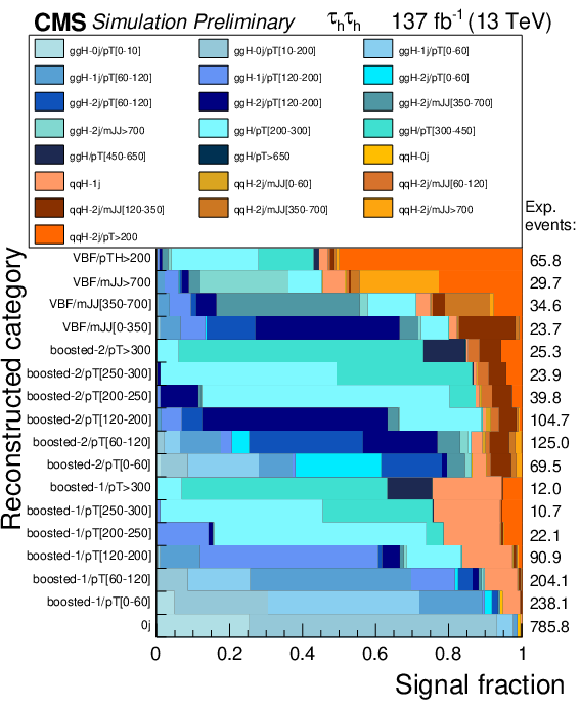
png pdf |
Figure 3:
Composition of the subcategories in terms of the STXS stage 1.2 processes in the $ {\tau _\mathrm {h}} {\tau _\mathrm {h}} $ final state. The numbers on the right indicate the total number of signal events expected in every subcategory. |
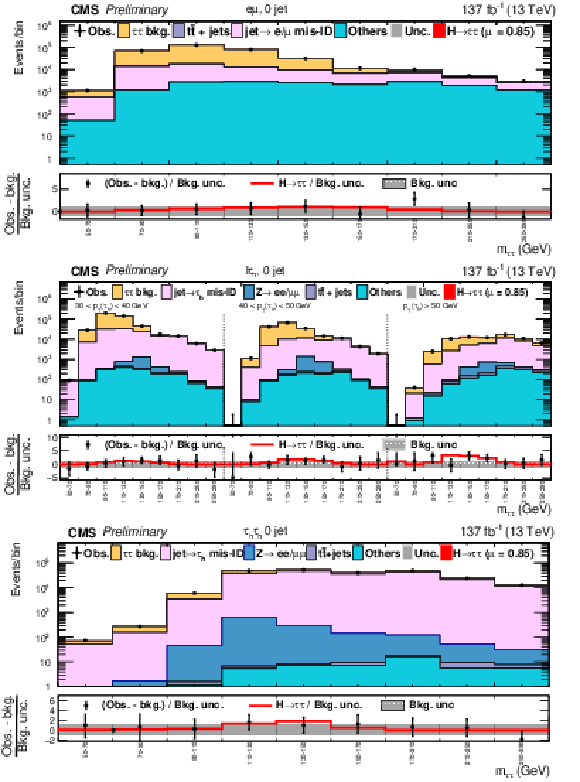
png pdf |
Figure 4:
Observed and predicted 2D distributions in the 0-jet category of the e$ \mu $ (top), $\ell {\tau _\mathrm {h}} $ (middle), and $ {\tau _\mathrm {h}} {\tau _\mathrm {h}} $ (bottom) final states. The normalization of the predicted background distributions corresponds to the result of the global fit. The signal distribution is normalized to its best fit signal strength. The background histograms are stacked. The "Others" background contribution includes events from diboson and single top quark production, as well as Higgs boson decays to a pair of W bosons. The uncertainty bands account for all sources of uncertainty, systematic as well as statistical, after the global fit. |
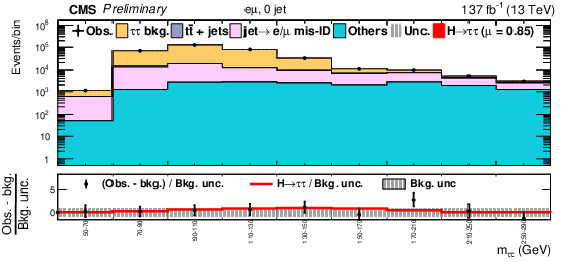
png pdf |
Figure 4-a:
Observed and predicted 2D distributions in the 0-jet category of the e$ \mu $ (top), $\ell {\tau _\mathrm {h}} $ (middle), and $ {\tau _\mathrm {h}} {\tau _\mathrm {h}} $ (bottom) final states. The normalization of the predicted background distributions corresponds to the result of the global fit. The signal distribution is normalized to its best fit signal strength. The background histograms are stacked. The "Others" background contribution includes events from diboson and single top quark production, as well as Higgs boson decays to a pair of W bosons. The uncertainty bands account for all sources of uncertainty, systematic as well as statistical, after the global fit. |

png pdf |
Figure 4-b:
Observed and predicted 2D distributions in the 0-jet category of the e$ \mu $ (top), $\ell {\tau _\mathrm {h}} $ (middle), and $ {\tau _\mathrm {h}} {\tau _\mathrm {h}} $ (bottom) final states. The normalization of the predicted background distributions corresponds to the result of the global fit. The signal distribution is normalized to its best fit signal strength. The background histograms are stacked. The "Others" background contribution includes events from diboson and single top quark production, as well as Higgs boson decays to a pair of W bosons. The uncertainty bands account for all sources of uncertainty, systematic as well as statistical, after the global fit. |
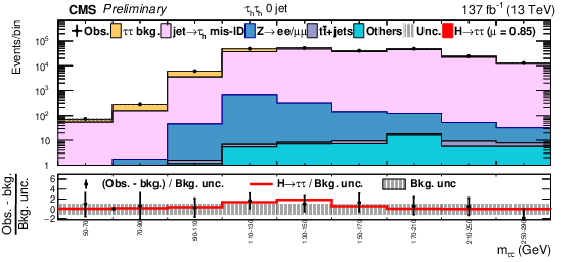
png pdf |
Figure 4-c:
Observed and predicted 2D distributions in the 0-jet category of the e$ \mu $ (top), $\ell {\tau _\mathrm {h}} $ (middle), and $ {\tau _\mathrm {h}} {\tau _\mathrm {h}} $ (bottom) final states. The normalization of the predicted background distributions corresponds to the result of the global fit. The signal distribution is normalized to its best fit signal strength. The background histograms are stacked. The "Others" background contribution includes events from diboson and single top quark production, as well as Higgs boson decays to a pair of W bosons. The uncertainty bands account for all sources of uncertainty, systematic as well as statistical, after the global fit. |
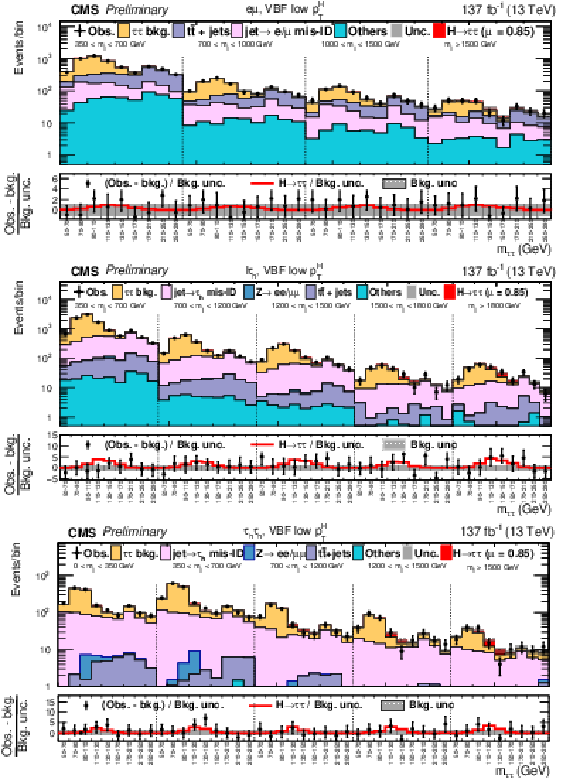
png pdf |
Figure 5:
Observed and predicted 2D distributions in the VBF low $ {{p_{\mathrm {T}}} ^{\mathrm{H}}} $ category of the e$ \mu $ (top), $\ell {\tau _\mathrm {h}} $ (middle), and $ {\tau _\mathrm {h}} {\tau _\mathrm {h}} $ (bottom) final states. |
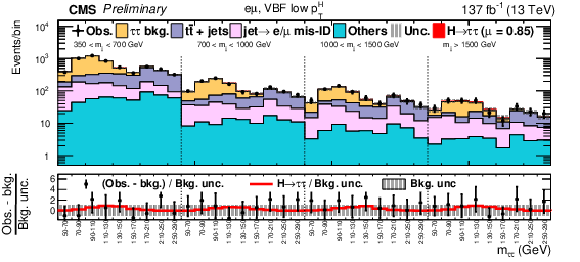
png pdf |
Figure 5-a:
Observed and predicted 2D distributions in the VBF low $ {{p_{\mathrm {T}}} ^{\mathrm{H}}} $ category of the e$ \mu $ (top), $\ell {\tau _\mathrm {h}} $ (middle), and $ {\tau _\mathrm {h}} {\tau _\mathrm {h}} $ (bottom) final states. |

png pdf |
Figure 5-b:
Observed and predicted 2D distributions in the VBF low $ {{p_{\mathrm {T}}} ^{\mathrm{H}}} $ category of the e$ \mu $ (top), $\ell {\tau _\mathrm {h}} $ (middle), and $ {\tau _\mathrm {h}} {\tau _\mathrm {h}} $ (bottom) final states. |

png pdf |
Figure 5-c:
Observed and predicted 2D distributions in the VBF low $ {{p_{\mathrm {T}}} ^{\mathrm{H}}} $ category of the e$ \mu $ (top), $\ell {\tau _\mathrm {h}} $ (middle), and $ {\tau _\mathrm {h}} {\tau _\mathrm {h}} $ (bottom) final states. |
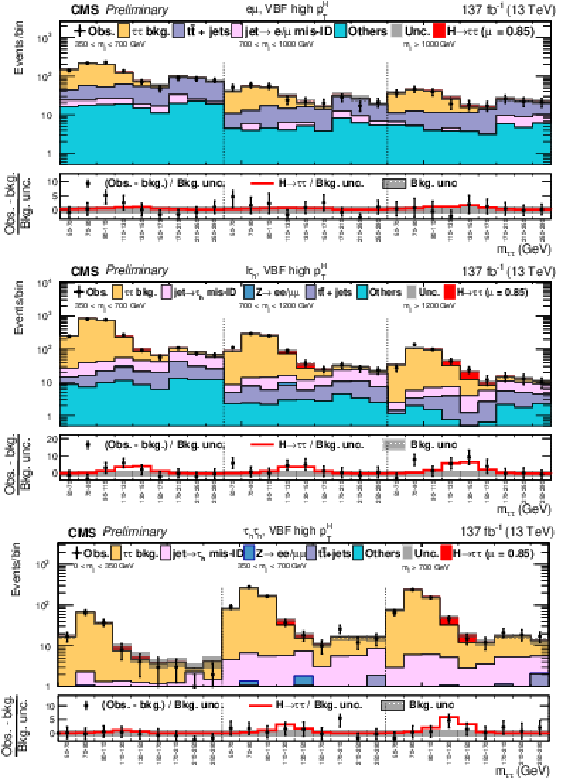
png pdf |
Figure 6:
Observed and predicted 2D distributions in the VBF high $ {{p_{\mathrm {T}}} ^{\mathrm{H}}} $ category of the e$ \mu $ (top), $\ell {\tau _\mathrm {h}} $ (middle), and $ {\tau _\mathrm {h}} {\tau _\mathrm {h}} $ (bottom) final states. |
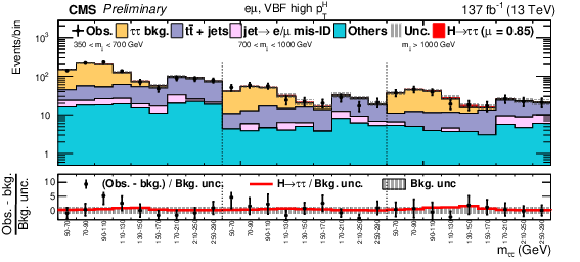
png pdf |
Figure 6-a:
Observed and predicted 2D distributions in the VBF high $ {{p_{\mathrm {T}}} ^{\mathrm{H}}} $ category of the e$ \mu $ (top), $\ell {\tau _\mathrm {h}} $ (middle), and $ {\tau _\mathrm {h}} {\tau _\mathrm {h}} $ (bottom) final states. |

png pdf |
Figure 6-b:
Observed and predicted 2D distributions in the VBF high $ {{p_{\mathrm {T}}} ^{\mathrm{H}}} $ category of the e$ \mu $ (top), $\ell {\tau _\mathrm {h}} $ (middle), and $ {\tau _\mathrm {h}} {\tau _\mathrm {h}} $ (bottom) final states. |
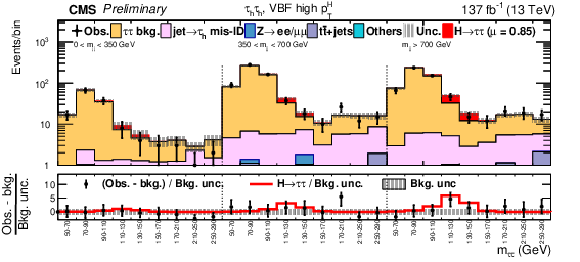
png pdf |
Figure 6-c:
Observed and predicted 2D distributions in the VBF high $ {{p_{\mathrm {T}}} ^{\mathrm{H}}} $ category of the e$ \mu $ (top), $\ell {\tau _\mathrm {h}} $ (middle), and $ {\tau _\mathrm {h}} {\tau _\mathrm {h}} $ (bottom) final states. |
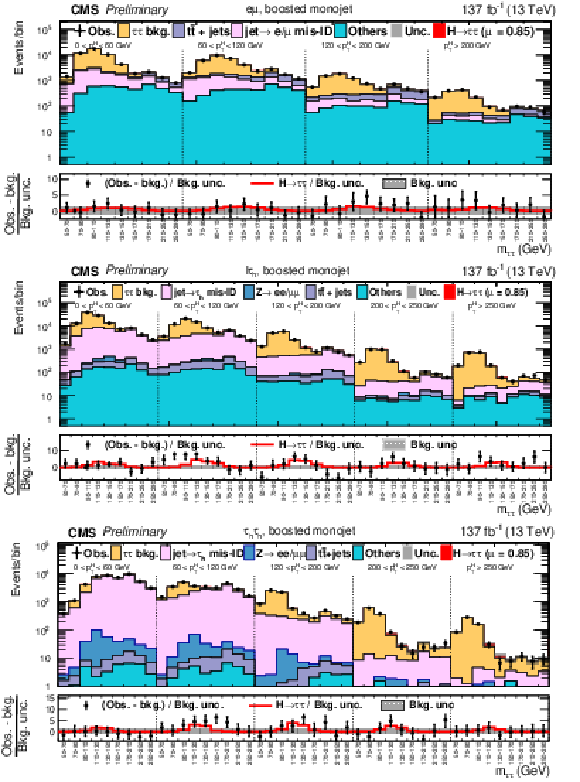
png pdf |
Figure 7:
Observed and predicted 2D distributions in the boosted monojet category of the e$ \mu $ (top), $\ell {\tau _\mathrm {h}} $ (middle), and $ {\tau _\mathrm {h}} {\tau _\mathrm {h}} $ (bottom) final states. |
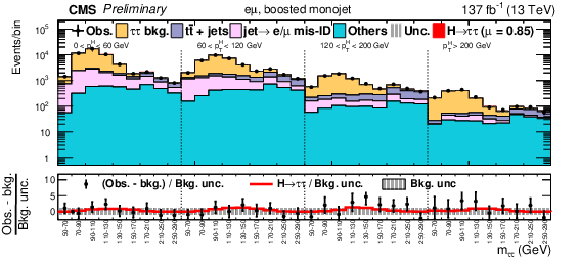
png pdf |
Figure 7-a:
Observed and predicted 2D distributions in the boosted monojet category of the e$ \mu $ (top), $\ell {\tau _\mathrm {h}} $ (middle), and $ {\tau _\mathrm {h}} {\tau _\mathrm {h}} $ (bottom) final states. |

png pdf |
Figure 7-b:
Observed and predicted 2D distributions in the boosted monojet category of the e$ \mu $ (top), $\ell {\tau _\mathrm {h}} $ (middle), and $ {\tau _\mathrm {h}} {\tau _\mathrm {h}} $ (bottom) final states. |
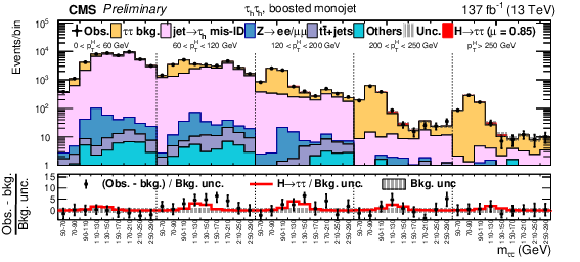
png pdf |
Figure 7-c:
Observed and predicted 2D distributions in the boosted monojet category of the e$ \mu $ (top), $\ell {\tau _\mathrm {h}} $ (middle), and $ {\tau _\mathrm {h}} {\tau _\mathrm {h}} $ (bottom) final states. |
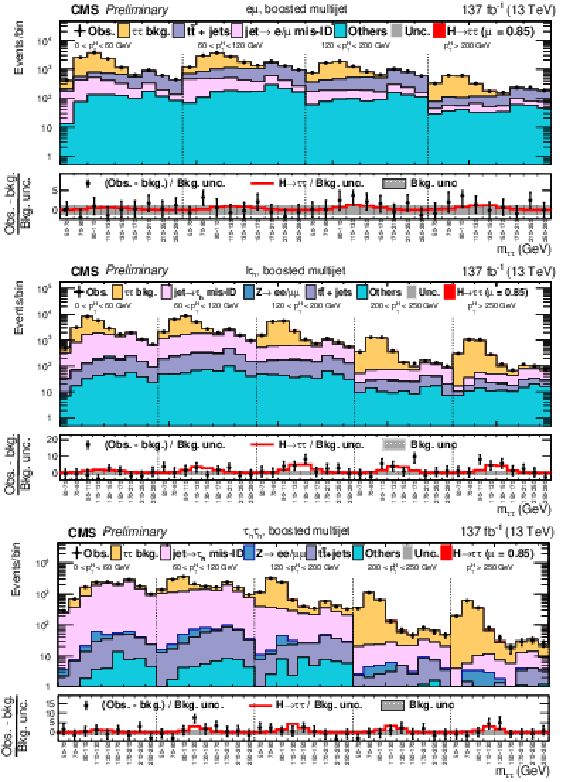
png pdf |
Figure 8:
Observed and predicted 2D distributions in the boosted multijet category of the e$ \mu $ (top), $\ell {\tau _\mathrm {h}} $ (middle), and $ {\tau _\mathrm {h}} {\tau _\mathrm {h}} $ (bottom) final states. |

png pdf |
Figure 8-a:
Observed and predicted 2D distributions in the boosted multijet category of the e$ \mu $ (top), $\ell {\tau _\mathrm {h}} $ (middle), and $ {\tau _\mathrm {h}} {\tau _\mathrm {h}} $ (bottom) final states. |

png pdf |
Figure 8-b:
Observed and predicted 2D distributions in the boosted multijet category of the e$ \mu $ (top), $\ell {\tau _\mathrm {h}} $ (middle), and $ {\tau _\mathrm {h}} {\tau _\mathrm {h}} $ (bottom) final states. |
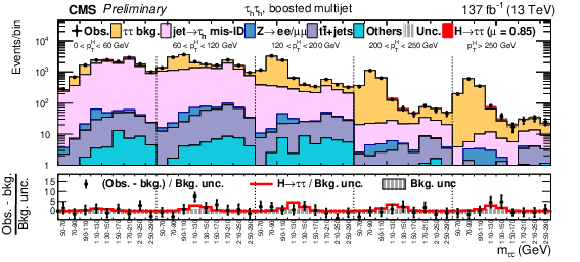
png pdf |
Figure 8-c:
Observed and predicted 2D distributions in the boosted multijet category of the e$ \mu $ (top), $\ell {\tau _\mathrm {h}} $ (middle), and $ {\tau _\mathrm {h}} {\tau _\mathrm {h}} $ (bottom) final states. |

png pdf |
Figure 9:
Observed and expected $ {m_{\tau \tau}} $ distribution obtained by reweighting every $ {m_{\tau \tau}} $ distribution of each category, year, and final state by the ratio between the signal and background yields in bins with 90 $ < {m_{\tau \tau}} < $ 150 GeV. The signal and background distributions are the result of a maximum likelihood fit with the inclusive signal strength for $\mathrm{H} \to \tau \tau $ events as the parameter of interest. The inset shows the difference between the observed data and the expected background distributions, together with the signal expectation. The reweighting does not affect the signal yield. |
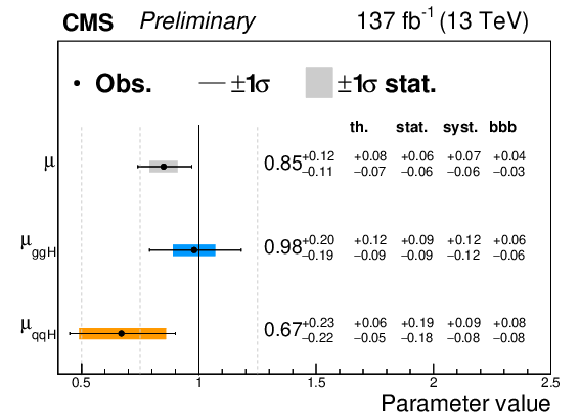
png pdf |
Figure 10:
Observed results of the fit to the production mode signal strength modifiers. The contributions to the total uncertainty in each parameter from the theoretical systematic, bin-by-bin systematic, other experimental systematic, and statistical components are shown. Also shown in black is the result of the fit to the inclusive signal strength modifier. |

png pdf |
Figure 11:
Correlation matrix between merged stage-1 STXS parameters. |

png pdf |
Figure 12:
Observed (black points) stage-1 parameters, obtained from the fit of all categories, data taking years, and final states. The contributions to the total uncertainty (black lines) in each parameter from the statistical component (colored squares) are shown. The ggHprocesses are indicated in blue while the qqH are indicated in yellow, the green squares can contain both ggHand qqH processes as they are solely based on topology. All parameters are measured simultaneously. The left plot corresponds to the process-based STXS stage-1 scheme, and the right plot to the topology-based STXS stage-1 scheme. |
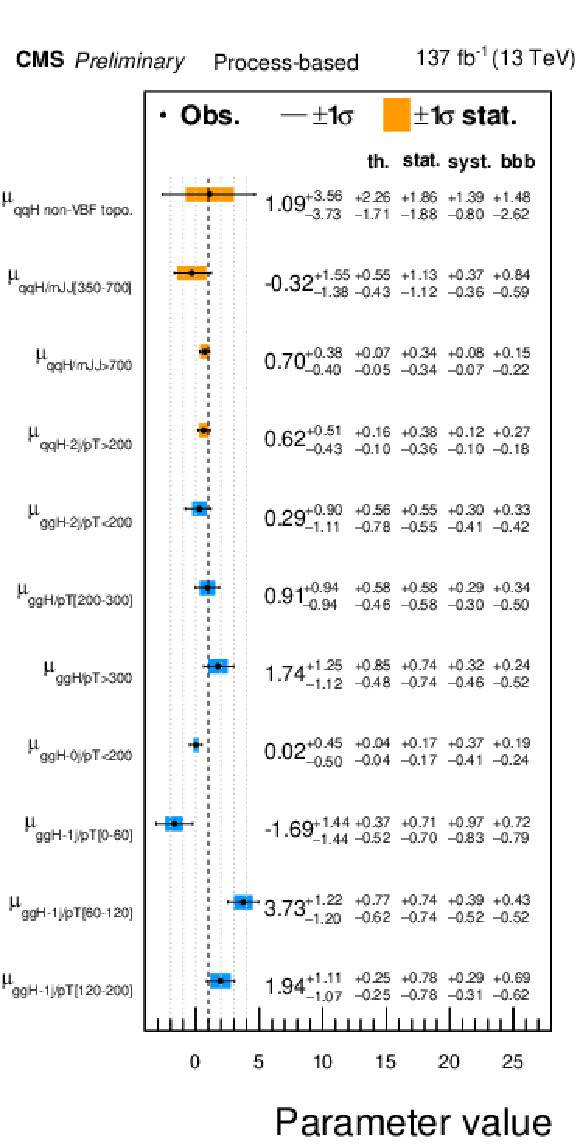
png pdf |
Figure 12-a:
Observed (black points) stage-1 parameters, obtained from the fit of all categories, data taking years, and final states. The contributions to the total uncertainty (black lines) in each parameter from the statistical component (colored squares) are shown. The ggHprocesses are indicated in blue while the qqH are indicated in yellow, the green squares can contain both ggHand qqH processes as they are solely based on topology. All parameters are measured simultaneously. The left plot corresponds to the process-based STXS stage-1 scheme, and the right plot to the topology-based STXS stage-1 scheme. |

png pdf |
Figure 12-b:
Observed (black points) stage-1 parameters, obtained from the fit of all categories, data taking years, and final states. The contributions to the total uncertainty (black lines) in each parameter from the statistical component (colored squares) are shown. The ggHprocesses are indicated in blue while the qqH are indicated in yellow, the green squares can contain both ggHand qqH processes as they are solely based on topology. All parameters are measured simultaneously. The left plot corresponds to the process-based STXS stage-1 scheme, and the right plot to the topology-based STXS stage-1 scheme. |
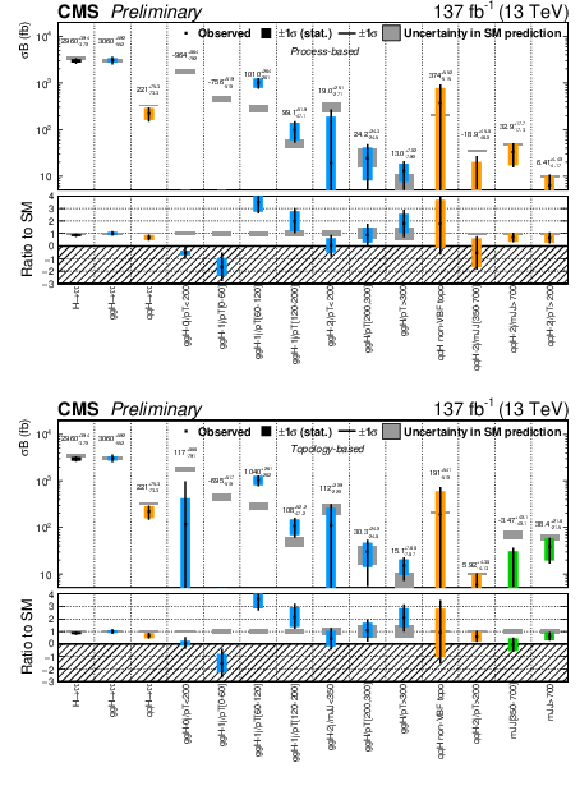
png pdf |
Figure 13:
Products of the cross section and branching fraction measured for the inclusive, stage-0, and stage-1 parameters. The top plot corresponds to the process-based stage-1 merging, and the bottom plot to the topology-based stage-1 merging. The ggHprocesses are indicated in blue while the qqH are indicated in yellow, the green squares can contain both ggHand qqH processes as they are solely based on topology. |

png pdf |
Figure 13-a:
Products of the cross section and branching fraction measured for the inclusive, stage-0, and stage-1 parameters. The top plot corresponds to the process-based stage-1 merging, and the bottom plot to the topology-based stage-1 merging. The ggHprocesses are indicated in blue while the qqH are indicated in yellow, the green squares can contain both ggHand qqH processes as they are solely based on topology. |
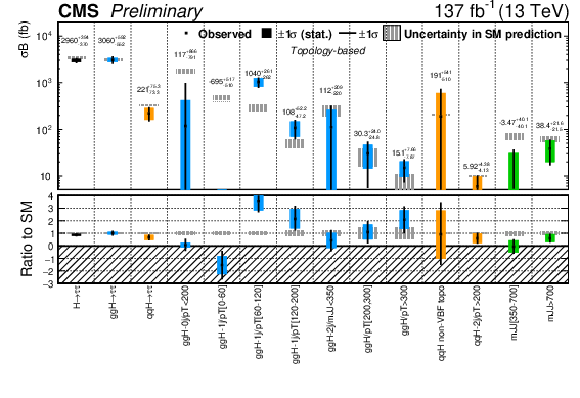
png pdf |
Figure 13-b:
Products of the cross section and branching fraction measured for the inclusive, stage-0, and stage-1 parameters. The top plot corresponds to the process-based stage-1 merging, and the bottom plot to the topology-based stage-1 merging. The ggHprocesses are indicated in blue while the qqH are indicated in yellow, the green squares can contain both ggHand qqH processes as they are solely based on topology. |
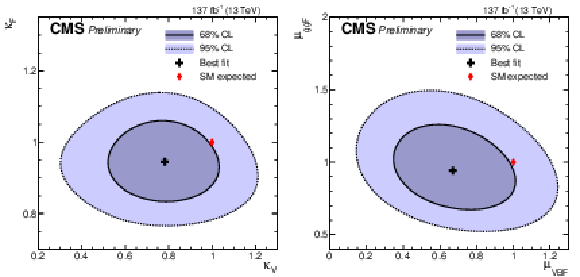
png pdf |
Figure 14:
Scan of the negative log-likelihood difference as a function of $\kappa _V$ and $\kappa _f$ (left) and the signal strengths for the ggF and VBF productions (right), for $ {m_{\mathrm{H}}} = $ 125.09 GeV. All nuisance parameters are profiled for each point. |

png pdf |
Figure 14-a:
Scan of the negative log-likelihood difference as a function of $\kappa _V$ and $\kappa _f$ (left) and the signal strengths for the ggF and VBF productions (right), for $ {m_{\mathrm{H}}} = $ 125.09 GeV. All nuisance parameters are profiled for each point. |

png pdf |
Figure 14-b:
Scan of the negative log-likelihood difference as a function of $\kappa _V$ and $\kappa _f$ (left) and the signal strengths for the ggF and VBF productions (right), for $ {m_{\mathrm{H}}} = $ 125.09 GeV. All nuisance parameters are profiled for each point. |
| Tables | |

png pdf |
Table 1:
Event selection requirements for the four di-$\tau $ decay channels. The trigger requirement is defined by a combination of trigger candidates with ${p_{\mathrm {T}}}$ over a given threshold, indicated inside square brackets. The triggers vary with the data taking year, which is indicated inside parentheses. The pseudorapidity thresholds come from trigger and object reconstruction constraints. The ${p_{\mathrm{T}}}$ thresholds for the lepton selection are driven by the trigger requirements, except for the $ {\tau _\mathrm {h}} $ candidate in the $\mu {\tau _\mathrm {h}} $ and e$ {\tau _\mathrm {h}} $ channels, and the subleading lepton in the e$ \mu $ channel, where they have been optimized to increase the signal sensitivity. |

png pdf |
Table 2:
Analysis categories. The results are extracted by performing a maximum likelihood fit of 2D distributions in these categories using the observables listed in the last column. |
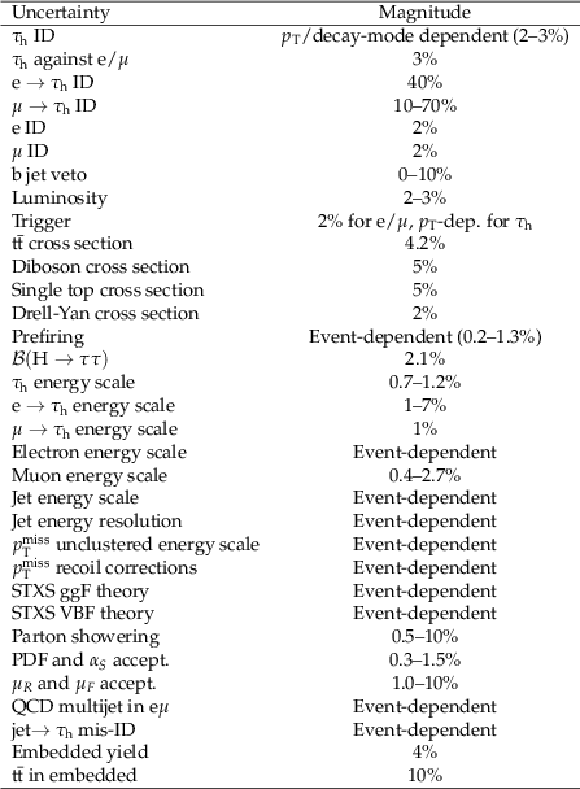
png pdf |
Table 3:
Sources of systematic uncertainties. |

png pdf |
Table 4:
Expected inclusive and stage-0 signal strengths per year with all final states combined, per final state with all years combined, and with all final states and years combined. |
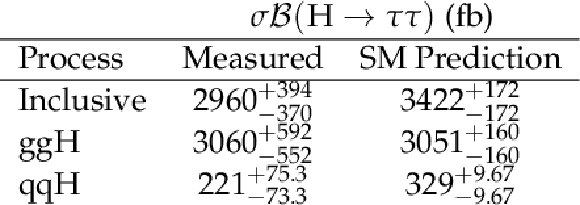
png pdf |
Table 5:
Product of the production cross section $\sigma $ and branching fraction $\mathcal {B}(\mathrm{H} \to \tau \tau)$ measured for the inclusive and stage-0 processes. |

png pdf |
Table 6:
Product of the production cross section $\sigma $ and branching fraction $\mathcal {B}(\mathrm{H} \to \tau \tau)$ measured in the process-based merging scheme. |

png pdf |
Table 7:
Product of the production cross section $\sigma $ and branching fraction $\mathcal {B}(\mathrm{H} \to \tau \tau)$ measured for the stage-1 processes in the topology-based merging scheme. |
| Summary |
| A measurement of the $\mathrm{H}\to\tau\tau$ signal strength, using events recorded in proton-proton collisions by the CMS experiment at a center-of-mass energy of 13 TeV and corresponding to an integrated luminosity of 137 fb$^{-1}$, has been presented. The event categories are designed to increase the signal sensitivity, to separate the gluon fusion and vector boson fusion productions, and to provide sensitivity to the simplified template cross section framework, especially at high Higgs boson ${p_{\mathrm{T}}}$ and in event topologies with jets. The results are extracted via maximum likelihood fits in two-dimensional distributions. All results are compatible with the standard model expectation. The best fit of the product of the observed $\mathrm{H}\to \tau \tau$ signal production cross section and branching fraction is $\mu=$ 0.85$ ^{+0.12}_{-0.11}$ times the standard model expectation, which corresponds to a significant improvement in precision with respect to previous measurements performed in the final state of two $\tau$ leptons. Cross sections and signal strengths have also been measured in the simplified template cross section framework, providing strong constraints and a good agreement with the standard model in topologies with jets and with Higgs bosons with a large transverse momentum. |
| References | ||||
| 1 | S. L. Glashow | Partial-symmetries of weak interactions | NP 22 (1961) 579 | |
| 2 | S. Weinberg | A model of leptons | PRL 19 (1967) 1264 | |
| 3 | A. Salam | Weak and electromagnetic interactions | in Elementary particle physics: relativistic groups and analyticity, N. Svartholm, ed., p. 367 Almqvist \& Wiksell, Stockholm, 1968 Proceedings of the eighth Nobel symposium | |
| 4 | F. Englert and R. Brout | Broken symmetry and the mass of gauge vector mesons | PRL 13 (1964) 321 | |
| 5 | P. W. Higgs | Broken symmetries, massless particles and gauge fields | PL12 (1964) 132 | |
| 6 | P. W. Higgs | Broken symmetries and the masses of gauge bosons | PRL 13 (1964) 508 | |
| 7 | G. S. Guralnik, C. R. Hagen, and T. W. B. Kibble | Global conservation laws and massless particles | PRL 13 (1964) 585 | |
| 8 | P. W. Higgs | Spontaneous symmetry breakdown without massless bosons | PR145 (1966) 1156 | |
| 9 | T. W. B. Kibble | Symmetry Breaking in Non-Abelian Gauge Theories | PR155 (1967) 1554 | |
| 10 | ATLAS Collaboration | Observation of a new particle in the search for the Standard Model Higgs boson with the ATLAS detector at the LHC | PLB 716 (2012) 1 | 1207.7214 |
| 11 | CMS Collaboration | Observation of a new boson at a mass of 125 GeV with the CMS experiment at the LHC | PLB 716 (2012) 30 | CMS-HIG-12-028 1207.7235 |
| 12 | CMS Collaboration | Observation of a new boson with mass near 125 GeV in pp collisions at $ \sqrt{s} = $ 7 and 8 TeV | JHEP 06 (2013) 081 | CMS-HIG-12-036 1303.4571 |
| 13 | ATLAS Collaboration | Measurements of the Higgs boson production and decay rates and coupling strengths using pp collision data at $ \sqrt{s}= $ 7 and 8 TeV in the ATLAS experiment | EPJC 76 (2016) 6 | 1507.04548 |
| 14 | CMS Collaboration | Precise determination of the mass of the Higgs boson and tests of compatibility of its couplings with the standard model predictions using proton collisions at 7 and 8 TeV | EPJC 75 (2015) 212 | CMS-HIG-14-009 1412.8662 |
| 15 | CMS Collaboration | Study of the mass and spin-parity of the Higgs boson candidate via its decays to Z boson pairs | PRL 110 (2013) 081803 | CMS-HIG-12-041 1212.6639 |
| 16 | ATLAS Collaboration | Evidence for the spin-0 nature of the Higgs boson using ATLAS data | PLB 726 (2013) 120 | 1307.1432 |
| 17 | CMS Collaboration | Constraints on the spin-parity and anomalous HVV couplings of the Higgs boson in proton collisions at 7 and 8 TeV | PRD 92 (2015) 012004 | CMS-HIG-14-018 1411.3441 |
| 18 | CMS Collaboration | Measurements of properties of the Higgs boson decaying into the four-lepton final state in pp collisions at $ \sqrt{s}= $ 13 TeV | JHEP 11 (2017) 047 | CMS-HIG-16-041 1706.09936 |
| 19 | CMS Collaboration | A measurement of the Higgs boson mass in the diphoton decay channel | PLB 805 (2020) 135425 | CMS-HIG-19-004 2002.06398 |
| 20 | ATLAS and CMS Collaborations | Combined measurement of the Higgs boson mass in $ pp $ collisions at $ \sqrt{s}= $ 7 and 8 TeV with the ATLAS and CMS experiments | PRL 114 (2015) 191803 | 1503.07589 |
| 21 | CMS Collaboration | Evidence for the direct decay of the 125 gev higgs boson to fermions | Nature Physics 10 (Jun, 2014) 557--560 | |
| 22 | ATLAS Collaboration | Evidence for the Higgs-boson Yukawa coupling to tau leptons with the ATLAS detector | JHEP 04 (2015) 117 | 1501.04943 |
| 23 | CMS Collaboration | Observation of the Higgs boson decay to a pair of $ \tau $ leptons with the CMS detector | PLB 779 (2018) 283 | CMS-HIG-16-043 1708.00373 |
| 24 | LHC Higgs Cross Section Working Group | Handbook of LHC Higgs cross sections: 4. deciphering the nature of the Higgs sector | 1610.07922 | |
| 25 | CMS Collaboration | Measurement of higgs boson production and decay to the $ \tau\tau $ final state | CMS-PAS-HIG-18-032 | CMS-PAS-HIG-18-032 |
| 26 | ATLAS Collaboration | Cross-section measurements of the Higgs boson decaying into a pair of $ \tau $-leptons in proton-proton collisions at $ \sqrt{s}= $ 13 TeV with the ATLAS detector | PRD 99 (2019) 072001 | 1811.08856 |
| 27 | CMS Collaboration | The CMS trigger system | JINST 12 (2017) P01020 | CMS-TRG-12-001 1609.02366 |
| 28 | CMS Collaboration | The CMS experiment at the CERN LHC | JINST 3 (2008) S08004 | CMS-00-001 |
| 29 | P. Nason | A new method for combining NLO QCD with shower Monte Carlo algorithms | JHEP 11 (2004) 040 | hep-ph/0409146 |
| 30 | S. Frixione, P. Nason, and C. Oleari | Matching NLO QCD computations with parton shower simulations: the POWHEG method | JHEP 11 (2007) 070 | 0709.2092 |
| 31 | S. Alioli, P. Nason, C. Oleari, and E. Re | A general framework for implementing NLO calculations in shower Monte Carlo programs: the POWHEG BOX | JHEP 06 (2010) 043 | 1002.2581 |
| 32 | S. Alioli et al. | Jet pair production in POWHEG | JHEP 04 (2011) 081 | 1012.3380 |
| 33 | S. Alioli, P. Nason, C. Oleari, and E. Re | NLO Higgs boson production via gluon fusion matched with shower in POWHEG | JHEP 04 (2009) 002 | 0812.0578 |
| 34 | K. Hamilton, P. Nason, E. Re, and G. Zanderighi | NNLOPS simulation of Higgs boson production | JHEP 10 (2013) 222 | 1309.0017 |
| 35 | K. Hamilton, P. Nason, and G. Zanderighi | Finite quark-mass effects in the NNLOPS POWHEG+MiNLO Higgs generator | JHEP 05 (2015) 140 | 1501.04637 |
| 36 | T. Sjostrand, S. Mrenna, and P. Z. Skands | A Brief Introduction to PYTHIA 8.1 | CPC 178 (2008) 852--867 | 0710.3820 |
| 37 | T. Sjostrand et al. | An introduction to PYTHIA 8.2 | CPC 191 (2015) 159 | 1410.3012 |
| 38 | J. Alwall et al. | The automated computation of tree-level and next-to-leading order differential cross sections, and their matching to parton shower simulations | JHEP 07 (2014) 079 | 1405.0301 |
| 39 | J. Alwall et al. | Comparative study of various algorithms for the merging of parton showers and matrix elements in hadronic collisions | EPJC 53 (2008) 473 | 0706.2569 |
| 40 | CMS Collaboration | Event generator tunes obtained from underlying event and multiparton scattering measurements | EPJC 76 (2016) 155 | CMS-GEN-14-001 1512.00815 |
| 41 | NNPDF Collaboration | Parton distributions for the LHC Run II | JHEP 04 (2015) 040 | 1410.8849 |
| 42 | NNPDF Collaboration | Parton distributions from high-precision collider data | EPJC 77 (2017) 663 | 1706.00428 |
| 43 | GEANT4 Collaboration | GEANT4 --- a simulation toolkit | NIMA 506 (2003) 250 | |
| 44 | CMS Collaboration | Particle-flow reconstruction and global event description with the CMS detector | JINST 12 (2017) P10003 | CMS-PRF-14-001 1706.04965 |
| 45 | CMS Collaboration | Performance of CMS muon reconstruction in pp collision events at $ \sqrt{s}= $ 7 TeV | JINST 7 (2012) P10002 | CMS-MUO-10-004 1206.4071 |
| 46 | CMS Collaboration | Performance of electron reconstruction and selection with the CMS detector in proton-proton collisions at $ \sqrt{s} = $ 8 TeV | JINST 10 (2015) P06005 | CMS-EGM-13-001 1502.02701 |
| 47 | M. Cacciari, G. P. Salam, and G. Soyez | The anti-$ k_t $ jet clustering algorithm | JHEP 04 (2008) 063 | 0802.1189 |
| 48 | CMS Collaboration Collaboration | Jet algorithms performance in 13 TeV data | CMS-PAS-JME-16-003, CERN, Geneva | |
| 49 | CMS Collaboration | Identification of heavy-flavour jets with the CMS detector in pp collisions at 13 TeV | JINST 13 (2018) P05011 | CMS-BTV-16-002 1712.07158 |
| 50 | CMS Collaboration | Performance of the CMS missing transverse momentum reconstruction in pp data at $ \sqrt{s} = $ 8 TeV | JINST 10 (2015) P02006 | CMS-JME-13-003 1411.0511 |
| 51 | CMS Collaboration | Performance of reconstruction and identification of $ \tau $ leptons decaying to hadrons and $ \nu_\tau $ in pp collisions at $ \sqrt{s}= $ 13 TeV | JINST 13 (2018) P10005 | CMS-TAU-16-003 1809.02816 |
| 52 | L. Bianchini, J. Conway, E. K. Friis, and C. Veelken | Reconstruction of the Higgs mass in $ H \to \tau\tau $ Events by Dynamical Likelihood techniques | J. Phys. Conf. Ser. 513 (2014) 022035 | |
| 53 | CMS Collaboration | Search for neutral MSSM Higgs bosons decaying to a pair of tau leptons in pp collisions | JHEP 10 (2014) 160 | CMS-HIG-13-021 1408.3316 |
| 54 | CMS Collaboration | Measurements of $ \mathrm{t\bar{t}} $H production and the CP structure of the Yukawa interaction between the higgs boson and top quark in the diphoton decay channel | Submitted to PRL | CMS-HIG-19-013 2003.10866 |
| 55 | CMS Collaboration | Measurement of the inclusive and differential Higgs boson production cross sections in the leptonic WW decay mode at $ \sqrt{s} = $ 13 TeV | Submitted to JHEP | CMS-HIG-19-002 2007.01984 |
| 56 | CMS Collaboration | Evidence for the 125 GeV Higgs boson decaying to a pair of $ \tau $ leptons | JHEP 05 (2014) 104 | CMS-HIG-13-004 1401.5041 |

|
Compact Muon Solenoid LHC, CERN |

|

|

|

|

|

|